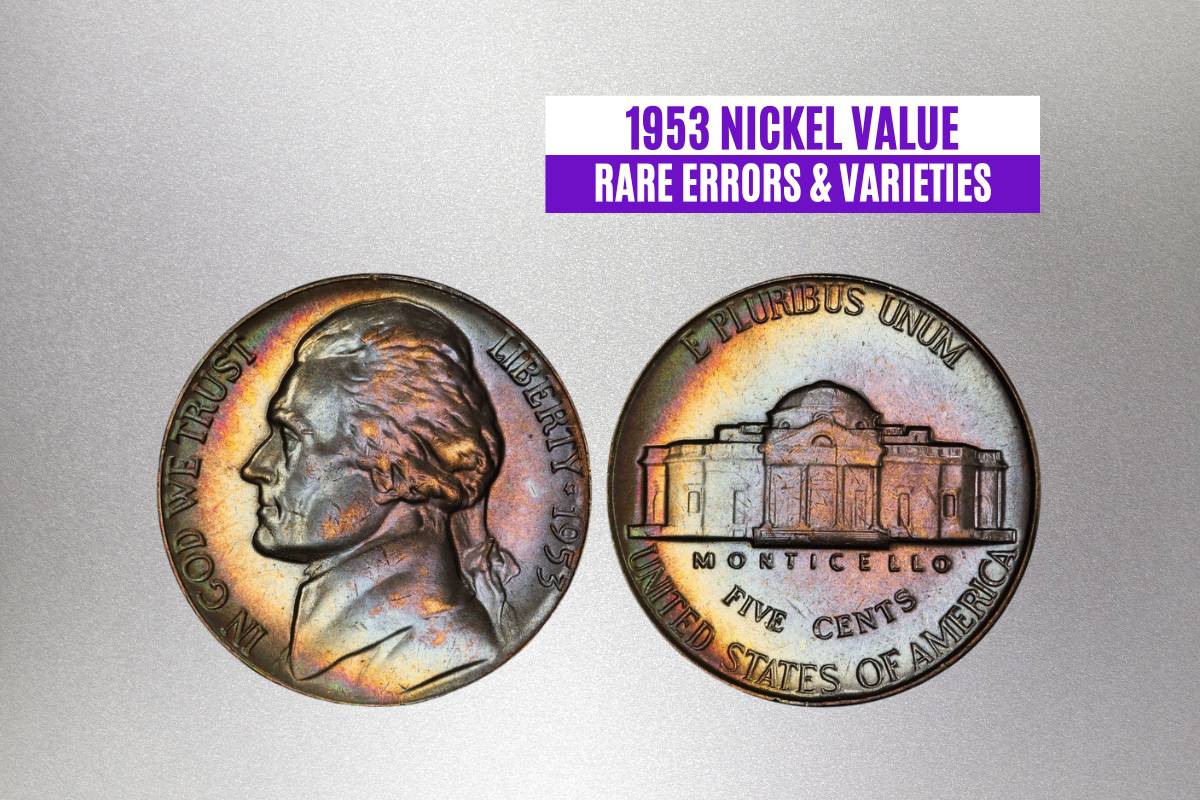Most nickels (especially those produced recently) are worth $0.05. But some, like the 1953 Jefferson nickel, are worth far more!
Like many other types of U.S. coins, Jefferson nickels that are several decades old can be quite valuable. In this guide, we’ll explore the 1953 nickel value and discuss which five-cent pieces released in 1953 have the highest (and lowest) estimated values.
1953 Jefferson Nickel Value Chart
| Variety | MS/PR-65 | MS/PR-66 | MS/PR-67 |
| 1953-P Nickel | $22.95 | $61 | $2,810 |
| 1953-P Nickel FS | $2,750 | $4,690 | $7,500 |
| 1953-D Nickel | $16.2 | $58 | $1,150 |
| 1953-D Nickel FS | $156 | $858 | $6,250 |
| 1953-S Nickel | $27 | $101 | $2,500 |
| 1953-S Nickel FS | $4,750 | $19,200 | / |
| 1953-P Proof Nickel | $33.75 | $47.25 | $68 |
| 1953-P Proof Nickel CAM | / | $81 | $143 |
| 1953-P Proof Nickel DCAM | / | $650 | $1,020 |
1953 Jefferson Nickel: History
The five-cent coin is one of the oldest types of U.S. coinage, but the Jefferson nickel is relatively new.
Although the U.S. Mint has produced nickels since 1794, the Jefferson nickel design didn’t emerge until the late 1930s. Notably, it remained virtually unchanged until 2004.
As such, the 1953 Jefferson nickel is essentially identical to all Jefferson nickels produced between 1938 and 1964 (except silver alloy nickels produced during World War II).
1953 Jefferson Nickel: Design
Before the Jefferson nickel, there was the Buffalo nickel.
The Buffalo nickel coin is beloved nowadays, but it was considered a comparatively unattractive coin at the time. Additionally, the fine details of the Buffalo nickel’s design became a nuisance for U.S. Mint staff, as striking the coin (up to standard) was consistently challenging.
So, in the late 1930s, the U.S. Mint held a nationwide competition for a new nickel coin design. Entrants had to stick to a few rules regarding the coin’s features, such as creating an image of President Thomas Jefferson for the coin’s obverse (front) face and an image of Jefferson’s Monticello for the coin’s reverse (back) face.
Felix Schlag, a German immigrant, created the winning design. And in 1938, Schlag’s design graced the very first Jefferson nickels. This same design is found on all 1953 nickels.
1953 Jefferson Nickel Obverse
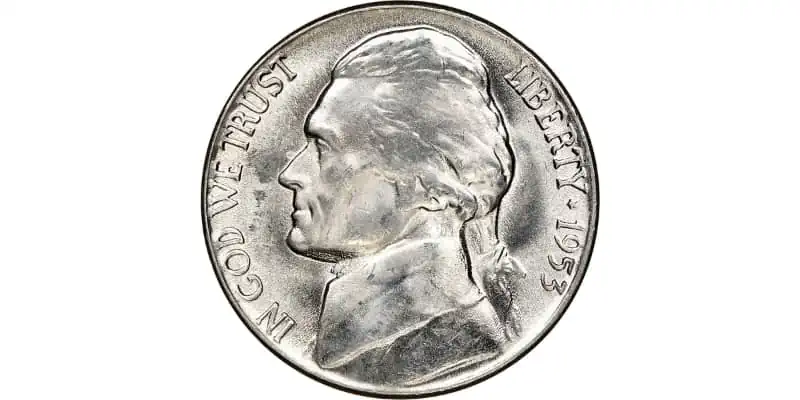
The 1953 Jefferson nickel’s obverse (front) face shows:
- The raised image (device) of President Thomas Jefferson, face in profile facing left
- The motto “IN GOD WE TRUST” on the left-hand side of the coin
- The legend “LIBERTY” on the right-hand side of the coin
- The year date (1953) on the right-hand side of the coin, next to the legend
1953 Jefferson Nickel Reverse
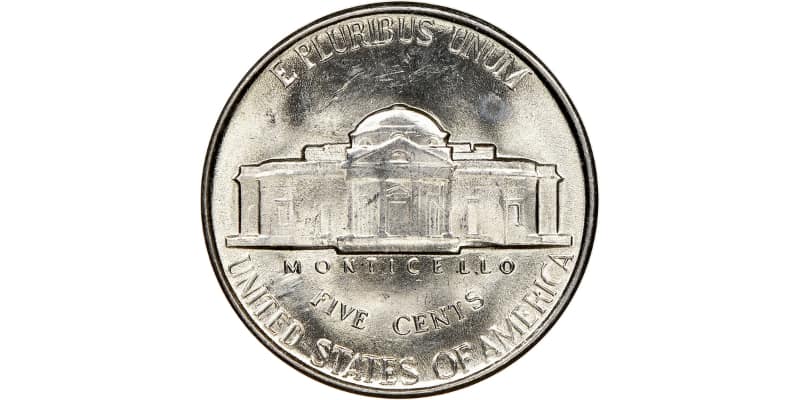
The 1953 Jefferson nickel’s reverse (back) face shows:
- The issuing nation “UNITED STATES OF AMERICA” on the bottom of the coin
- The coin denomination “FIVE CENTS” above the issuing nation
- The legend “MONTICELLO” above the denomination
- The raised image (device) of Monticello in the center of the coin
- The mint mark (D or S) on the right side of the device, except for nickels struck at the Philadelphia Mint, which have no mint mark
- The motto “E PLURIBUS UNUM” at the top of the coin
1953 Jefferson Nickel: Features and Specifications
The 1953 Jefferson nickel comes in three mint varieties and two strike types (regular and proof). However, regardless of these differences, all nickels struck in 1953 have several shared qualities, including size and weight.
For example, 1953 Jefferson nickels:
- Weigh five grams (about 0.17 ounces)
- Are composed of 25% nickel and 75% copper
- Are 21.2 millimeters (about 0.83 inches) in diameter
- Have plain (smooth) edges
How Much Is a 1953 Jefferson Nickel Worth?
According to the CPG values derived from Greysheet, a 1953-P (No Mint Mark) Jefferson nickel in circulated condition is worth between $0.30 (G-4) and $0.35 (AU-50). In uncirculated condition (mint state), a 1953-P Jefferson nickel can be worth up to $2,810 (MS-67).
1953 Jefferson Nickel: Value Comparison
The value of a 1953 Jefferson nickel varies between $0.30 and $19,200. As with many other U.S. coins, the value of a 1953 Jefferson nickel is influenced by mint marks, coin condition (grade), and strike type (regular versus proof).
But there’s another aspect to consider when determining the value of a Jefferson nickel: design detail. Several of the most valuable 1953 Jefferson nickels are called “Full Step” coins, as they show the full set of steps (six steps) in the Monticello design (on the coin’s reverse side).
This design detail is comparatively rare because coin dies tend to wear out over time. Because the steps are such a small detail, older dies can fail to impress them into planchets. Heavy circulation can also cause this tiny design detail to wear away, leaving coins with a much smoother surface that lacks the detail of uncirculated pieces.
Without further ado, let’s compare the value of all 1953 Jefferson nickels to discover which are the most (and least) valuable!
1953-P No Mint Mark Jefferson Nickel Value
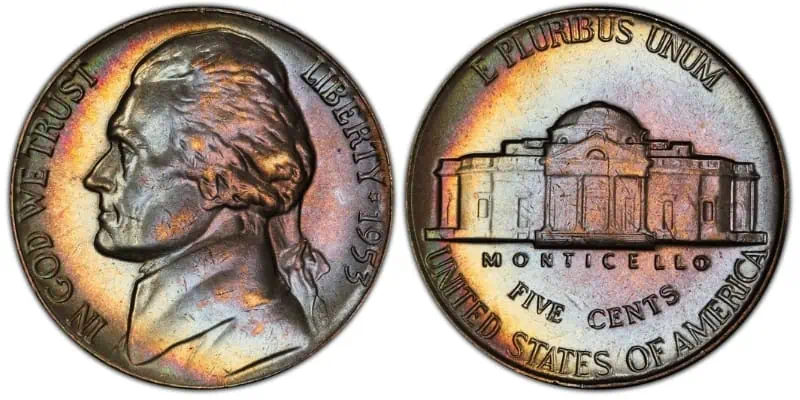
The Philadelphia Mint struck more than 46 million Jefferson nickels in 1953. It’s thought that about 37 million of these coins exist today.
None of these nickels have a mint mark, so you can assume that any 1953 Jefferson nickel that doesn’t have a mint mark on its reverse side was produced at the Philadelphia Mint.
These coins are called 1953 No Mint Mark or 1953-P Jefferson nickels. A 1953 No Mint Mark nickel in good condition (G-4) is worth about $0.30, while one in about uncirculated condition (AU-50) is worth about $0.35.
These nickels can be worth hundreds or even thousands of dollars in mint state condition. While an MS-60 1953-P Jefferson nickel is only worth about $0.55, one with a grade of MS-67 can sell for $2,810 or more!
Still, the Full Steps (FS) version of this coin is generally more valuable.
Full Steps
Full Steps (FS) 1953 No Mint Mark Jefferson nickels are exceptionally rare, and there are likely fewer than 10,000 of these coins in existence.
Because they’re rare and feature a higher-quality design, they’re highly sought after by numismatists (coin collectors). The higher demand results in a higher overall value. It’s also crucial to mention that FS nickels are rarely ever discovered in circulated condition, with most having a grade of MS-60 or higher.
For example, an MS-67 FS 1953-P Jefferson nickel is worth about $7,500. That’s 150,000 times the coin’s original value of $0.05!
1953-D Jefferson Nickel Value
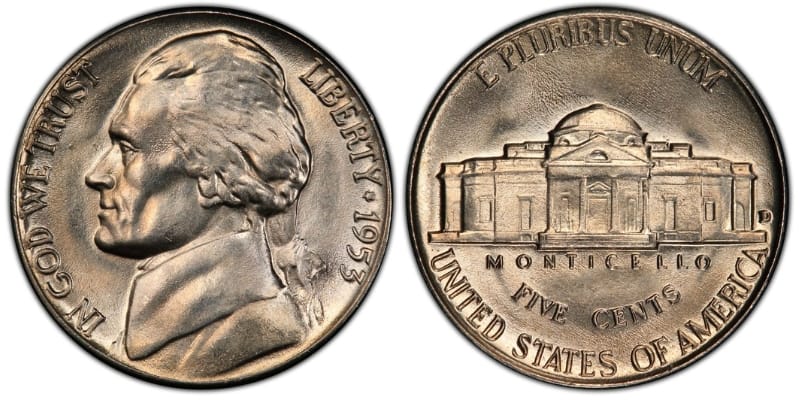
The Denver Mint produced just under 60 million Jefferson nickels in 1953. Of these, roughly 48 million are still around today. This makes the 1953-D Jefferson nickel far more commonplace than the 1953-P No Mint Mark nickel.
This coin is worth about $0.30 in good condition (G-4) and $0.35 in about uncirculated condition (AU-50). A 1953-D Jefferson nickel with a grade of MS-60 is worth about $0.40, while one with a grade of MS-67 is worth about $1,150.
The price difference between an MS-66 and an MS-67 1953-D Jefferson nickel is stark, with an MS-66 having an estimated value of only $58.
Full Steps
1953-D FS Jefferson nickels are worth between $68 (MS-63) and $6,250 (MS-67). If you’re uncertain whether your 1953-D Jefferson nickel is a Full Steps coin, be sure to have it evaluated by a reputable coin grading service like PCGS or NGC.
1953-S Jefferson Nickel Value
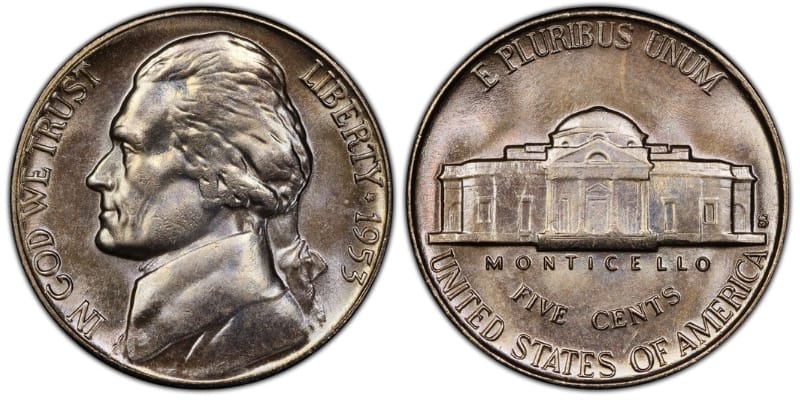
The San Francisco Mint facility struck the fewest Jefferson nickels of any U.S. Mint facility in 1953. All told, they produced a little over 19 million nickels. Still, about 15 million of these coins exist today.
Even though 1953-S Jefferson nickels are the rarest of all regular strike nickels struck in 1953, they’re worth about the same as 1953-D and 1953-P nickels when found in good (G-4) or about uncirculated (AU-50) condition.
For example, a 1953-S Jefferson nickel with a grade of G-4 is worth about $0.30, while one with a grade of AU-50 is worth about $0.35. But these San Francisco Mint coins are a little more valuable in mint state condition.
An MS-67 1953-S Jefferson nickel is worth about $2,500! This five-cent piece is even more valuable if it has the Full Steps design on its reverse side.
Full Steps
A 1953-S FS Jefferson nickel is worth between $2,000 (MS-64) and $19,200 (MS-66). In terms of estimated value, there’s no other 1953 Jefferson nickel worth quite as much as this Full Steps coin.
1953-P Proof Jefferson Nickel Value
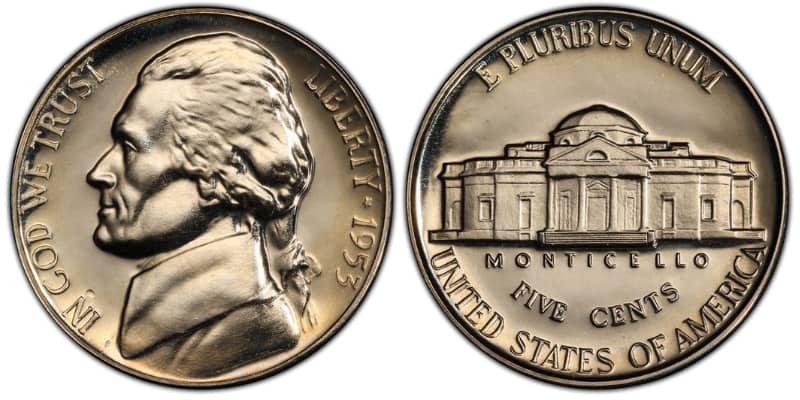
Unlike regular strike coins, proof strike coins are solely designed for collectors. As such, they tend to be higher-quality pieces with sharper details. Because these proof coins aren’t meant for circulation, most are in uncirculated condition.
The Philadelphia Mint was the only U.S. Mint facility to produce proof strike Jefferson nickels in 1953. This facility struck 128,800 proof nickels that year, the vast majority (about 85,000) of which still exist today.
Proof strike 1953 Jefferson nickels come in three colors:
- Proof
- Proof Cameo
- Proof Deep Cameo
Depending on the type, a 1953-P proof strike nickel could be worth as little as $6.75 or as much as $12,000!
Proof
The non-cameo proof strike 1953 Jefferson nickel is worth about $6.75 in PR-60 condition. In PR-67 condition, this coin is worth about $68. In PR-69 condition, it’s worth approximately $208.
Overall, a standard 1953-P proof nickel is less valuable than regular strike 1953 Jefferson nickels with Full Steps (of a similar grade). That said, cameo and deep cameo proof nickels can be quite valuable.
Proof Cameo
Cameo refers to a finishing effect on a proof coin. This effect gives the coin a subtle two-tone appearance, with a darker background (field) and a brighter raised image (device).
A proof cameo 1953 Jefferson nickel is worth $143 in PR-67 condition and $910 in PR-69 condition. That’s far more than standard proof strike coins of the same type and year!
Still, deep cameo nickels (with a more dramatic two-tone look) are worth even more.
Proof Deep Cameo
This coin is relatively easy to identify, as it has an almost black field (background) that contrasts beautifully with the frosted raised images (devices) of Jefferson and Monticello. A deep cameo 1953 Jefferson nickel (proof strike) is worth between $1,020 (PR-67) and $12,000 (PR-69).
In 2013, one of these coins (a PR-68 piece) set a new auction record, selling for $15,275.
1953 Jefferson Nickel: Rare Errors
Everyone makes mistakes from time to time, including the U.S. Mint! Some coins struck in U.S. Mint facilities have imperfections or defects, and these errors can make a coin exceptionally valuable.
When discussing the 1953 Jefferson nickel, there are three rare errors to watch for:
- The inverted D error
- The doubled die obverse (DDO) error
- The re-engraved obverse design error
Let’s explore these errors in greater detail and discover how valuable these error coins can be.
1953 Jefferson Nickel Inverted D Error
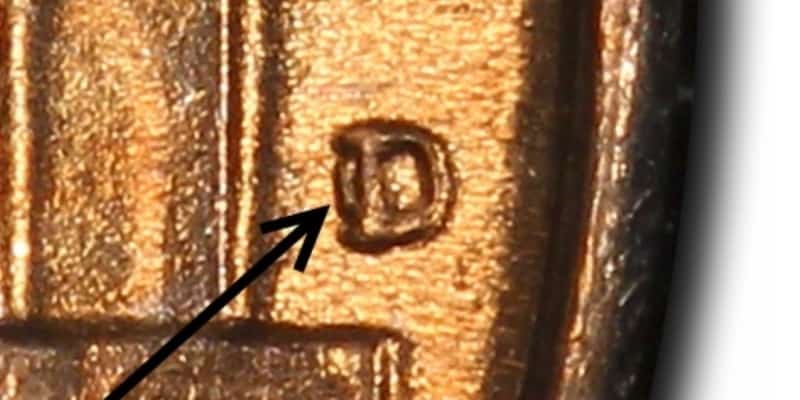
The Denver Mint struck more Jefferson nickels than any other U.S. Mint facility in 1953, so it’s not surprising that some of these coins ended up featuring a few flaws. One of the most common 1953-D Jefferson nickel errors is the Inverted D error.
Like non-error 1953-D nickels, this error coin comes in regular and Full Steps varieties. Depending on this coin’s condition and design (FS or not), it’s worth between $50 and $700.
Because the Inverted D mint mark error can be challenging to identify, it’s crucial to submit your 1953-D Jefferson nickel to a reputable coin grading service to confirm whether or not it has this error.
1953 Jefferson Nickel DDO Error
The doubled die obverse (DDO) error is seen throughout a wide range of coins, including the 1953-D Jefferson nickel.
You can identify this error by looking for a doubling of design elements along the nickel’s obverse (front) side. This doubling can be very subtle or extremely apparent, and coins showing more dramatic doubling tend to be worth more than those with hard-to-notice doubling.
The 1953 DDO Jefferson nickel can be worth hundreds of dollars. A proof strike 1953 Jefferson nickel (PR-69) with the DDO error sold for $1,293 in 2014.
1953 Jefferson Nickel Re-Engraved Obverse Design Error
Coins with many details can be challenging to produce in mass quantities, as coin dies wear out over time. The ribbon in Jefferson’s hair is one design element that U.S. Mint staff struggled to get just right, as seen with the re-engraved obverse design error.
U.S. Mint staff re-engraved the coin die used to produce Jefferson nickels, but they went a little overboard near the ribbon, creating a jagged design that stands out from the smoother, more practiced lines of the design. This coin’s value varies significantly, with values ranging from $35 to $550, depending on the coin’s grade.
Frequently Asked Questions
The 1953 Jefferson nickel differs from today’s nickels in several ways. If you’re eager to learn more about this five-cent coin, check out the frequently asked questions below!
How Many 1953 Jefferson Nickels Exist Today?
It’s believed that about 100 million 1953 Jefferson nickels (regular strike) exist today. Additionally, just over 101,000 proof strike 1953 Jefferson nickels in private collections. Consequently, most of the nickels minted in 1953 are still around today.
What’s the Most Ever Spent on a 1953 Jefferson Nickel?
The auction record for the 1953 Jefferson nickel is $24,000. In 2019, a buyer set this record while bidding on an MS-65 Full Steps 1953-S Jefferson nickel.
Final Thoughts
The 1953 nickel value varies depending on the coin’s mint mark, grade, and strike type. Design elements, most notably the steps on the coin’s reverse side, can also contribute to a 1953 Jefferson’s nickel final value.
Although 1953 Jefferson nickels were originally worth $0.05, these coins are currently worth between $0.30 (No Mint Mark, G-4) and $19,200 (Full Steps 1953-S, MS-66).
Are you a coin collector looking to explore coin values? If so, check out these related articles now!

